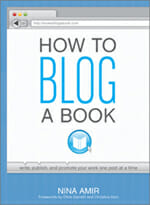by Nina Amir (@NinaAmir)
I wrote about Nina last April when I published Blogging and Books: 4 Questions from Nina Amir. We have a common interest in helping authors use their blogs to produce books, and this article shows just how much thought Nina has put into this subject. Enjoy it, I know I did.
Most bloggers simply blog. Day in and day out, they write their posts and publish them in Cyberspace. They produce a lot of content, but as one post after another pile up in front of the last, the older ones get lost in a deep dark blog hole. There they remain.
If you are like most bloggers, you may not realize your blog represent a gold mine filled with content that can be published beyond the blogososphere. Stop looking forward to the next new post you will write, and realize “There’s gold in them ‘thar posts.” You can find nuggets of content that can be refined into a variety of manuscripts. In other words, you can find publishable gold in your blog. You just have to do a bit of prospecting.
Indeed, every blog post you write, have ever written or will write in the future has the potential of becoming part of a book. If you stop thinking like a blogger and begin thinking like a writer—or, even better, like an aspiring author—you’ll find your blog holds more publishable content than you know what to do with. Additionally, your blog can turn into a way for you to produce books quickly and easily.
Prospecting for Gold in Existing Posts
If you’ve been blogging for a long time, you’ve probably got several books in your blog. You might, therefore, want to drill several mines to find ore. To begin, consider what topics you’ve written about most often. These subjects will have the most posts available for use in a book.
It’s a good idea to know what angle you might want to take with your book, what content you want in your book, etc. I suggest creating a content plan prior to repurposing your blog posts, or “booking a blog,” a term the author of this particular blog, Joel Friedlander, coined. You can then search out posts to fit into that plan, or outline.
You can do a search though your tags (in WordPress) or labels (in Blogger) to find posts on the topics you need to flesh out your content plan—assuming you labeled them well using such keywords. You can also search for posts in your categories, again assuming you have “filed” your posts by subject matter.
The search widget on your blog also will pull up posts by topic. Just put in a key word and search for relevant posts much as you would on any other website or when using a search engine like Google.
Once you have a set of posts related to a certain topic, you can begin considering which ones to place into a book. Copy and past the content into a word processing document to create a manuscript.
Refining Your Gold into Publishable Products
In addition to extracting your ore—your posts—you’ll need to refine it and then create something out of it. Just like gold can be made into a necklace or a ring, you’ll need to decide what type of book you want to compile. You might want to explore your available content prior to deciding, or you can decide beforehand and then go mining for the content you need.
The following are a few suggestions for the types of publishable gold you might end up discovering and producing:
- Tip Books: If you often write the kind of blog posts that offer your readers advice of one type or another, you can compile a tip book. The easiest type of tip book has one tip per page or a list of tips. Each tip can be just a sentence long, or you can write a paragraph or two of explanation. For example, it’s possible that in the last five years of blogging you might have written posts that contain 10-101 tips on ways to keep gophers from eating plants, baking better muffins, saving money on taxes, generating business leads. Maybe your blogging over just the past year has produced enough content for a tip book called, 50 Tips for Faster Financing, 101 Tips for Baking Better Bread or 99 Tips for Sewing Sensational Prom Dresses.
- Step Books: These are very similar to tip books; however, they offer your readers a certain number of steps for accomplishing a goal. Look through your blog content for a possible series of posts in which you discussed a way to do or achieve something. It’s also possible that you wrote unrelated posts on this topic that you can piece together into steps. You also may have written just one post discussing the steps to accomplishing a task, and you now can take that post and flesh out the steps for a short book. You can include one step per page with just a few paragraphs of explanation, or you can flesh out the idea to a full-length book. You might discover that over the course of the last few years, by blogging on the topic of decreasing debt you actually produced posts that come together nicely to produce a book called 10 Steps to Effortlessly Reducing Debt. Or maybe in just the past month you wrote a series of 12 posts the fit nicely into a book you can title 12 Steps Toward Raising More Charitable Children.
- Booklets: You can take any topic about which you blog often and turn into a booklet. Why? Because a booklet simply is a short book, usually between 34-36 pages long. The difference between a tip book, step book and a booklet is simple: A booklet is more content heavy. It might contain tips or steps, but they will be fleshed out with at least a few pages of copy per chapter. I find that booklets lend themselves well to series of blog posts, especially posts that are around 500-750 words in length.
- Rx Books: If your blog is prescriptive in general, meaning it offers solutions, advice, information, answers to problems, etc., then it is filled with posts that will fill a prescriptive nonfiction book. Just like a doctor’s prescription provides the medicine someone ill needs to feel better, a prescriptive nonfiction book offers medicine for readers who want to feel better in some way. Your blog might be mined for a Rx like, 101 Ways to Train Your Bird to STOP Talking, How to Move Up the Corporate Ladder Two Rungs at a Time, The Single Man’s Guide to Eating Well Without Cooking, or The Guide to Being Organized.
- Memoirs and Collections of Essays: If you blog in a more personal fashion, discussing your experiences, your thoughts, and your memories, you can choose a certain time period or experience (or even similar experiences) you have had and go back to mine these posts from your blog. Use them as the foundation for a memoir; you can map out the rest of the story you want to tell and write the rest of the memoir on or off the blog. If you discovered a group of posts all on similar themes or topics, you could put these together into a collection of essays, much like the Chicken Soup for the Soul series. These types of essay collections have become quite popular. You might discover many different types of ore in your blog that you can mine for such books, maybe causing you to start a series of your own.
- Anthologies: If you often host guest bloggers, you can dig through these contributions to create an anthology. You will need to ask permission from your guest bloggers to include them in your book. Many such anthologies are compiled and given away rather than sold; these make incentives for getting subscribers to your mailing list.
Purposely Creating Gems
The last way to mine your blog for gold involves purposely setting out to create these valuable nuggets. Rather than booking your blog, blog a book. In other words, create a content plan for a series of posts that will fill a book. Then write the book in post sized bits, and publish these on your blog.
Any one of these books can be produced as an ebook or as a printed book. Many of them lend themselves to the short book form. Tip books, step books and booklets are short, easy and quick to compile, as well as inexpensive to print; most are saddle-stitched (stapled) and can be produced on a booklet press or at Kinkos. In most cases, these can be upgraded from saddle stitched to perfect bound (paperback) by simply changing the design so it has more pages.
So what are you waiting for? Start mining your blog today for publishable gold. You’ll be discovering buckets of useable ore—posts—before you know it.
 Nina Amir, Inspiration-to-Creation Coach, inspires people to combine their purpose and passion so they Achieve More Inspired Results. She motivates both writers and non-writers to create publishable and published products, careers as authors and to achieve their goals and fulfill their purpose.
Nina Amir, Inspiration-to-Creation Coach, inspires people to combine their purpose and passion so they Achieve More Inspired Results. She motivates both writers and non-writers to create publishable and published products, careers as authors and to achieve their goals and fulfill their purpose.
The author of How to Blog a Book, Write, Publish and Promote Your Work One Post at a Time (Writer’s Digest Books), Nina has also self-published 10 short books and is a sought after editor, proposal consultant, book and author coach, and blog-to-book coach. The founder of Write Nonfiction in November, she writes four blogs, including Write Nonfiction NOW!, How to Blog a Book and As the Spirit Moves Me.
Amazon links are affiliate links. Photo of a painting by Tyrone Comfort, 1934 by freeparking


